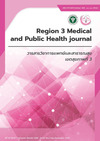Retrospective Study of Universal Neonatal Hearing Screening Program in Nakhonsawan: Anticipating Improved Outcomes
Keywords:
Universal newborn hearing screening, Hearing loss, TEOAEsAbstract
Introduction: Newborn hearing loss is a significant health concern that can impact speech, language, and cognitive development. The Universal Neonatal Hearing Screening (UNHS) program aims to promptly identify hearing impairments in newborns for timely interventions and improved outcomes.
Objectives: This retrospective study assessed the effectiveness of the UNHS program in Nakhonsawan, specifically regarding coverage rate, identification of high-risk newborns, referral rates, prevalence of hearing loss, and audiological risk factors.
Methods: Data were collected from November 2021 to May 2023 at all 20 participating hospitals in the UNHS program. Newborns were screened using either Transient Evoked Otoacoustic Emissions (TEOAEs) or Automatic Auditory Brainstem Response (AABR) tests. Newborns with abnormal screening results underwent further diagnostic testing using Auditory Brainstem Response (ABR) or Auditory Steady-State Response (ASSR) tests for confirmation.
Results: A total of 2,623 newborns were screened, with a coverage rate of 66.9%. Among the screened infants, 15.0% were classified as high-risk. The two-stage screening protocol significantly reduced referral rates from 18.6% to 6.6%. The most prevalent risk factors in Nakhonsawan were ototoxic medications (80.3%), preterm labor (32.5%), and NICU stays longer than five days (21.7%).
Conclusion: The UNHS program in Nakhonsawan plays a crucial role in improving outcomes for infants with hearing loss and provides valuable information to managers and healthcare personnel involved in public health. Continuing to implement and support the UNHS program is essential to ensure the improved well-being of newborns.
Keywords: Universal newborn hearing screening, Hearing loss, TEOAEs
References
Connolly JL, Carron JD, Roark SD. Universal newborn hearing screening: are we achieving the Joint Committee on Infant Hearing (JCIH) objectives? Laryngoscope 2005;115(2):232–6.
Fortnum HM, Summerfield AQ, Marshall DH, Davis AC, Bamford JM. Prevalence of permanent childhood hearing impairment in the United Kingdom and implications for universal neonatal hearing screening: questionnaire based ascertainment study. BMJ 2001; 323;536–40.
Erenberg A, Lemons J, Sia C, Trunkel D, Ziring P. Newborn and infant hearing loss: detection and intervention. American Academy of Pediatrics. Task Force on Newborn and Infant Hearing 1999;103:527–30.
Robertson CM , Howarth TM, Bork DL, Dinu IA. Permanent bilateral sensory and neural hearing loss of children after neonatal intensive care because of extreme prematurity: a thirty-year study. Pediatrics 2009;123(5):797–807.
Jakubı´kova´ J, Z. Kaba’tova, Pavlovcinova’G, Profant M. Newborn hearing screening and strategy for early detection of hearing loss in infants. Int. J. Pediatr Otorhinolaryngol 2009;73(4): 607–12.
Isaacson G. Universal Newborn Hearing Screening and Intervention. Advances in Otolaryngology-Head and Neck Surgery 2001;15:1-19.
Molini E, Calzolaro L, Lapenna R, Ricci G. Universal newborn hearing screening in Umbria region, Italy. International journal of pediatric Otorhinolaryngology 2016;82:92-7.
Sloot F, Hoeve HL, de Kroon ML, Goedegebure A, Carlton J, Griffiths HJ, et al. Inventory of current EU paediatric vision and hearing screening programmes. J Med Screen 2015;22:55–64.
Mehl AL, Thomson V. The Colorado newborn hearing screening project 1992-1999: on the threshold of effective population-based universal newborn hearing screening. Pediatrics 2002;109: E7.
Bubbico L, Tognola G, Greco A, Grandori F. Universal newborn hearing screening programs in Italy: survey of year 2006, Acta Otolaryngol 2008; 128(12):1329–36.
ASHA: American Speech-Language-Hearing Association.Joint Committee on infant Hearing. Position Statement. ASHA 1994;36:38-41.
Wroblewska-Seniuk KE, Dabrowski P, Szyfter W, Mazela J. Universal newborn hearing screening: methods and results, obstacles, and benefits. Pediatr Res 2017;81:415–22.
Force USPST. Universal screening for hearing loss in newborns: US preventive services task force recommendation statement. Pediatrics 2008; 122:143–8.
Downs MP, Yoshinaga-Itano C. The efficacy of early identification and intervention for children with hearing impairment. Pediatr Clin N Am 1999; 46:79–87.
Caluraud S, Marcolla-Bouchetemble A, de Barros A, Moreau-Lenoir F, de Sevin E, Rerolle S,et al. Newborn hearing screening: analysis and outcomes after 100,000 births in upper-Normandy French region. Int J Pediatr Otorhinolaryngol 2015;79:829–33.
American Academy of Pediatrics JCoIH. Year 2007 position statement: principles and guidelines for early hearing detection and intervention programs. Pediatrics 2007;120:898–921.
Joint Committee on Infant H, American Academy of A, American Academy of P, American Speech -Language-Hearing A, Directors of S, Hearing Programs in State H, Welfare A. Year 2000 position statement: principles and guidelines for early hearing detection and intervention programs. Joint Committee on Infant Hearing, American Academy of Audiology, American Academy of Pediatrics, American Speech-Language-Hearing Association and Directors of Speech and Hearing Programs in State Health and Welfare Agencies. Pediatrics 2000;106:798–817.
Yang HC, Sung CM, Shin DJ, Cho YB, Jang CH, Cho HH. Newborn hearing screening in prematurity: fate of screening failures and auditory maturation. Clin Otolaryngol. 2017;42(3): 661-7.
Dommelen P, Straaten HM, Verkerk PH. NICU Neonatal Hearing Screening Working Group. Ten-year quality assurance of the nationwide hearing screening programme in Dutch neonatal intensive care units. Acta Paediatr Oslo Nor 2011;100(8): 1097-103.
Iley KL, Addis RJ. Impact of technology choice on service provision for universal newborn hearing screening within a busy district hospital. JPerinatol 2000;20(8): 122‑7.
Downloads
Published
How to Cite
Issue
Section
License
Copyright (c) 2024 Region 3 Medical and Public Health Journal - วารสารวิชาการแพทย์และสาธารณสุข เขตสุขภาพที่ 3

This work is licensed under a Creative Commons Attribution-NonCommercial-NoDerivatives 4.0 International License.



